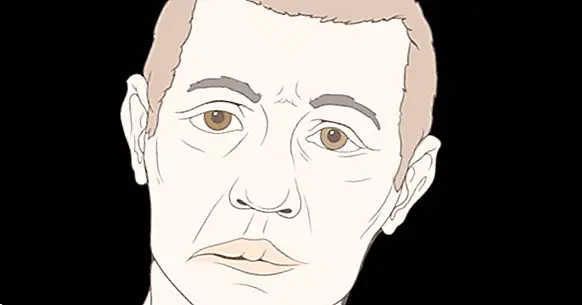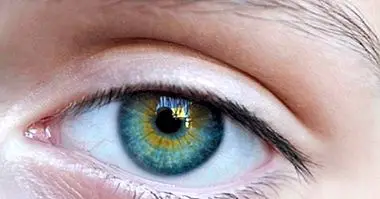Bell's palsy: symptoms, causes and treatment
We are such a quiet day walking down the street and suddenly we noticed that we can not close our eyes. We try to talk and we realize that we can not move half of our mouth or we feel extremely weak. We drool or drop our food or drink from our mouths, as if we were leaving the anesthetized dentist. We go running to the hospital and after several exams and urgent examinations they indicate that he is not giving us a stroke but that we are ** suffering a Bell's palsy **.
What is this? What are we? In this article we are going to talk about this paralysis.
Bell's palsy
Bell's palsy, also called simply facial paralysis to frigore or mononeuropathy of the seventh cranial nerve is a neurological disorder in which part or all of the face suffers a paralysis or a decrease in muscle tone. This paralysis comes from an injury or problem in the facial nerve or seventh cranial nerve, usually in the presence of inflammation. This nerve allows the human being mobility of the facial muscles, so that their alteration generates the difficulty or absence of voluntary movement.
It is a relatively common disorder . The most common symptoms are the aforementioned paralysis (which usually occurs only in one half of the face), the inability to close one of the eyes, the deviation of the mouth towards the side that keeps movement, drooling and difficulties for talk and feed It is also common to tear.
Occasionally headaches may appear, jaw pain or perceptual alterations, such as hyperacusis or inability to detect the taste in the affected hemifield. These symptoms usually appear suddenly, although they may take between two and three days to emerge and manifest themselves in their maximum effect.
Although at first glance it may not seem too limiting, it must be borne in mind that it can cause considerable harm: the difficulties in communicating can greatly affect interpersonal relationships or even at work. Also these communicational difficulties and other such as those when drinking or feeding can affect the patient's self-esteem and suppose a great source of frustration and stress.
Bell's palsy is a disorder that can occur at any time during the life cycle, although it is more frequent in adulthood and middle age (it is rare before the age of sixteen). This type of paralysis is usually temporary (although it can last for months).
- Maybe you're interested: "Cerebral palsy: types, causes, symptoms and treatment"
Causes
As we have said, this paralysis is caused by the inflammation of the seventh cranial nerve. However the causes of this inflammation are unknown, being idiopathic (ie of unknown cause) in most cases. In fact, another of the names of this disorder is idiopathic facial paralysis .
In some cases, it seems to be related to infection with viruses such as herpes simplex, herpes zoster or HIV. Some cases have also appeared since the vaccination against influenza. It can also arise from the suffering of any injury or traumatic brain injury that can damage the nerve.
Another element that could cause it is the suffering of some type of tumor that generates compression or directly affects the nerve , as well as a stroke. Finally it should be mentioned that it has been detected that the fact of being pregnant increases the risk of suffering from this type of paralysis, as well as the suffering of disorders such as diabetes or respiratory diseases.
- Related article: "Brain tumor: types, classification and symptoms"
Treatment
Bell's palsy is in the vast majority of cases temporary (around 80%), so it is not usual to need a specific treatment for this alteration. In those that are necessary because paralysis persists, the possible reason for this must be explored, analyzing why the seventh cranial nerve malfunctions and applying a specific treatment for each case. For example, the use of antibiotics or antivirals in case of bacterial or viral infection, or the treatment of a possible tumor.
It is usual to apply steroids and anti-inflammatories to reduce the inflammation of the nerve and the surrounding area. The bioelectrical stimulation of muscle and physiotherapy they can also facilitate the excitation and functioning of the nerve.
In cases where there are difficulties to close the eyes artificial tears are also applied to keep them clean and hydrated. By last there is the possibility of using decompression surgery , although it is not recommended and in many cases its real effectiveness is discussed.
Forecast
The prognosis in most cases is positive: symptoms usually begin to subside gradually within the first few weeks in a process that can last several months. The recovery tends to be complete, although this will depend on its cause and the type of affectation that it generates. In other cases weakness or small spasms may appear , or alterations such as the sense of taste.
In any case, it is essential to go to a doctor's office as soon as possible if the face or part of it is paralyzed: it must be borne in mind that a sudden facial paralysis can also be the consequence of a stroke that could have severe consequences or even lead to death .
Bibliographic references:
- National Institute of Neurological Disorders and Stroke (2016). Bell's palsy [Published online]. Available at: //espanol.ninds.nih.gov/trastornos/paralisis_de_bell.htm
- León-Arcila, M.E .; Benzur-Alalus, D. and Álvarez-Jaramillo, J. (2013). Bell's palsy, report of a case. Spanish Journal of Oral and Maxillofacial Surgery, 35 (4). Barcelona.



















